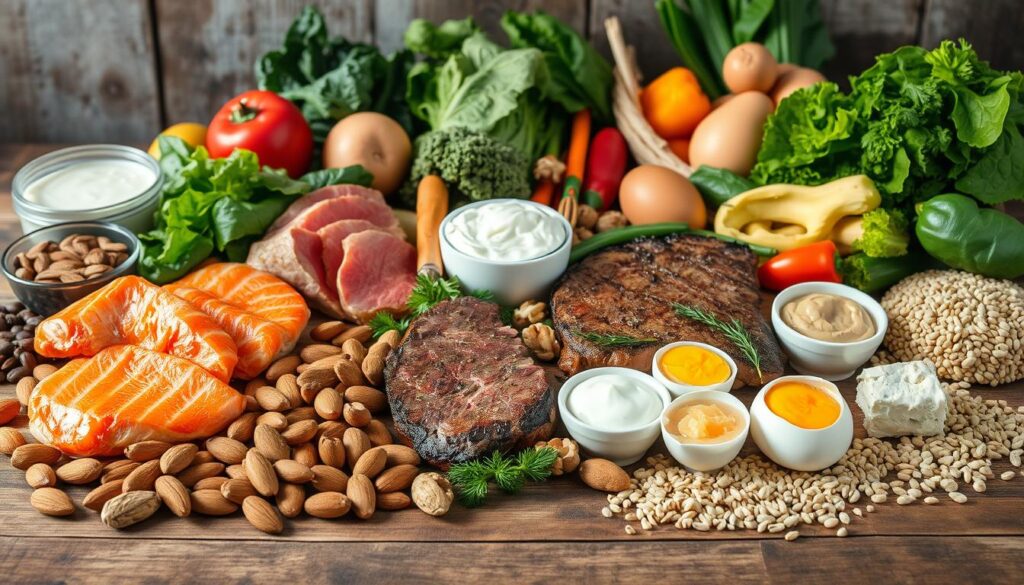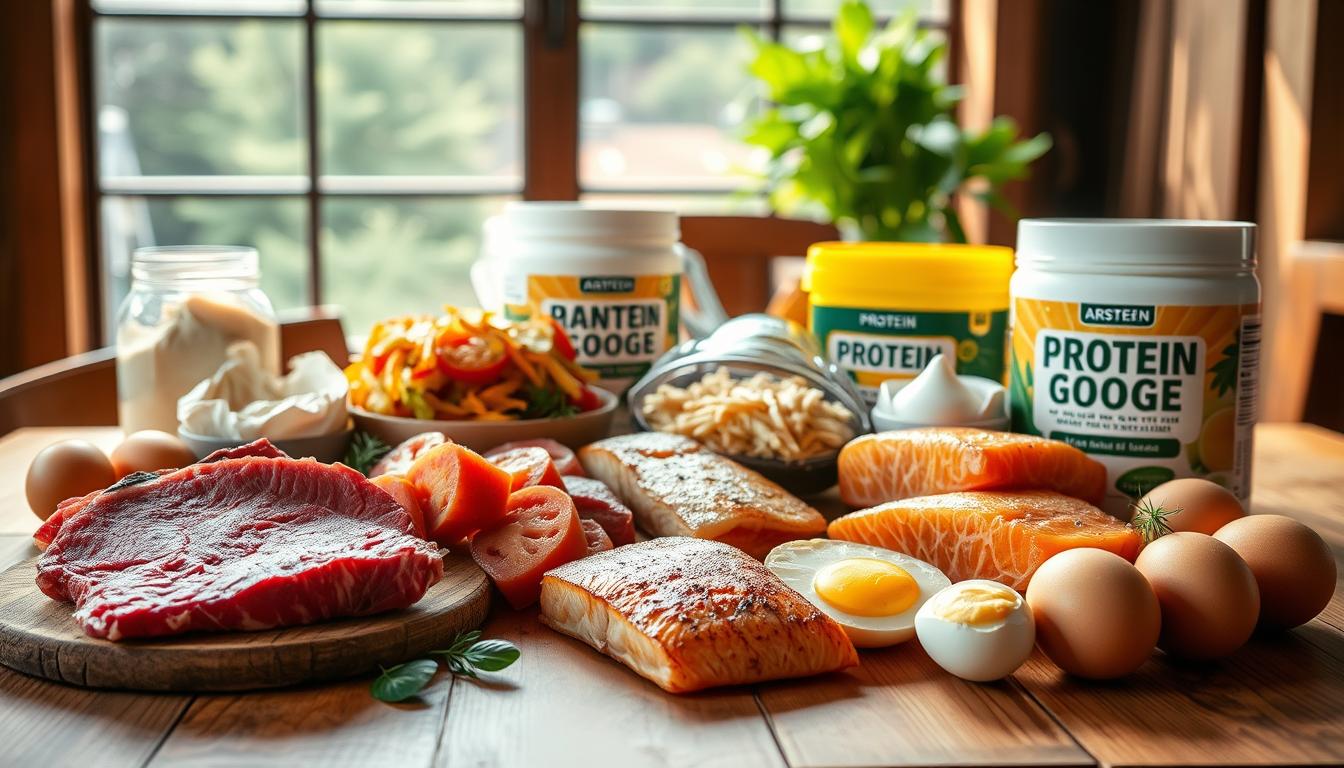As Bill Orban, a renowned fitness expert, once said, “You can’t turn back the clock, but you can wind it up again.” This quote resonates with individuals over 40 who are determined to maintain their physical strength and muscle mass. As people age, maintaining muscle becomes increasingly challenging.
A high-protein diet is essential for building and repairing muscle tissue, making it a critical component of any fitness regimen. Understanding the role of protein in muscle development is crucial for making informed decisions about diet and training programs.
Key Takeaways
- High-protein diets are crucial for muscle growth and repair.
- Certain proteins are more effective for muscle building than others.
- Nutritional strategies play a significant role in achieving fitness goals over 40.
- A well-planned diet can help individuals over 40 maintain muscle mass.
- Understanding protein’s role in muscle development is key to a successful fitness regimen.
Why Protein Becomes More Critical After40
As we age, our bodies undergo a series of changes that make protein more crucial for maintaining muscle mass and overall health. The natural aging process brings about a decline in physical performance and changes in body composition, making adequate protein intake essential.
Age-Related Muscle Loss: Understanding Sarcopenia
Sarcopenia, or age-related muscle loss, is a condition characterized by the loss of muscle fibers and a decrease in muscle protein synthesis. This condition can lead to frailty, reduced mobility, and increased risk of falls and fractures. Consuming sufficient protein-rich foods is vital for mitigating the effects of sarcopenia. Research suggests that older adults require more protein than younger individuals to maintain muscle mass.

Metabolic Changes That Affect Protein Utilization
Aging also brings about metabolic changes that affect how the body utilizes protein. The efficiency of protein synthesis decreases with age, making it more challenging for the body to build and repair muscle tissue. A high-protein diet can help counteract this decline by providing the necessary building blocks for muscle maintenance and growth. It’s essential to distribute protein intake throughout the day to maximize its utilization.
Best Protein Sources for Muscle Growth Over40
For individuals over 40, identifying the right protein sources is essential for supporting muscle growth and overall health. As we age, our bodies undergo various changes that affect how we process and utilize protein.
Premium Animal Protein Sources
Animal proteins are considered high-quality due to their complete amino acid profiles. These proteins provide all essential amino acids necessary for muscle repair and growth.
Lean Meats and Poultry
Lean meats such as chicken, turkey, and lean cuts of beef are excellent sources of protein. They are rich in essential amino acids and can be easily incorporated into meals. Grass-fed beef, for instance, offers a higher protein content and better fatty acid profile.
Fish and Seafood Options
Fish and seafood are not only rich in protein but also in omega-3 fatty acids, which are beneficial for heart health and muscle recovery. Salmon, tuna, and sardines are among the top choices for their high protein and omega-3 content.
Dairy Products for Muscle Recovery
Dairy products like whey protein and casein are highly effective for muscle recovery. Whey protein is absorbed quickly, making it ideal post-workout, while casein provides a sustained release of amino acids, beneficial before bedtime.
Plant-Based Protein Powerhouses
For those following a plant-based diet, there are numerous high-protein options available. These include legumes, beans, nuts, and seeds, which can be combined to achieve a complete amino acid profile.
Legumes and Beans
Legumes and beans are rich in protein and fiber, making them an excellent choice for muscle growth and overall health. Examples include lentils, chickpeas, and black beans.
Nuts, Seeds, and Their Derivatives
Nuts and seeds, such as almonds, chia seeds, and hemp seeds, are not only high in protein but also in healthy fats. They can be consumed as snacks or added to meals.
Plant Protein Combinations for Complete Amino Acid Profiles
Combining different plant-based proteins can provide all essential amino acids. For example, pairing legumes with grains or nuts with seeds can create a complete protein profile.
Protein Quality: Understanding Biological Value and Digestibility
The quality of protein is determined by its biological value (BV) and digestibility. Biological value measures the proportion of absorbed protein that is retained by the body, while digestibility refers to how easily the protein is absorbed. High-quality proteins have both high BV and digestibility, making them more effective for muscle growth.
“The quality of protein is just as important as the quantity. Choosing proteins with high biological value and digestibility can significantly impact muscle growth and recovery.”
Optimal Protein Intake for Adults Over40
The importance of optimal protein intake for adults over 40 cannot be overstated, as it directly impacts muscle health and longevity. As people age, their protein needs change due to factors such as decreased muscle mass and changes in metabolism.
Calculating Your Personal Protein Requirements
To determine individual protein needs, consider factors such as age, weight, activity level, and fitness goals. A general guideline is to consume at least 0.8 grams of protein per kilogram of body weight daily, but this can increase to 1.2-1.6 grams or more for active individuals or those aiming to build muscle.
| Activity Level | Daily Protein Intake Recommendation |
|---|---|
| Sedentary | 0.8 grams/kg body weight |
| Moderately Active | 1.2-1.4 grams/kg body weight |
| Very Active | 1.6-2.2 grams/kg body weight |
Distribution Throughout the Day vs. Single Large Doses
Research suggests that distributing protein intake throughout the day can be more effective for muscle growth and maintenance than consuming a single large dose. This approach helps maintain a positive nitrogen balance and supports muscle protein synthesis.
Aim to consume 20-30 grams of protein per meal, spaced out over 3-5 main meals and 2-3 snacks in between.
Adjusting Intake Based on Activity Level and Goals
Adjusting protein intake based on activity level and specific fitness goals is crucial. For example, individuals engaging in resistance training may require more protein to support muscle repair and growth.
Summary: Optimal protein intake for adults over 40 involves calculating personal protein requirements, distributing intake throughout the day, and adjusting based on activity level and fitness goals.
Strategic Timing of Protein Consumption
Optimizing protein intake timing is crucial for individuals over 40 looking to maximize muscle growth and recovery. The strategic use of protein at different times relative to workouts and sleep can significantly impact muscle health.
Pre-Workout Protein: Setting the Stage for Growth
Consuming protein before a workout can help prepare the muscles for the upcoming stress. A pre-workout protein shake or meal can provide essential amino acids that support muscle function and reduce muscle damage during exercise. Aim to consume a balanced meal with protein 1-2 hours before your workout.
Post-Workout Window: Maximizing Recovery
The post-workout window is critical for muscle recovery and growth. Consuming protein within 30-60 minutes after exercise can help stimulate muscle protein synthesis, promoting recovery and muscle growth. A mix of fast-digesting proteins like whey can be particularly effective during this period.
Bedtime Protein: Supporting Overnight Muscle Synthesis
Consuming protein before bed can support overnight muscle recovery and growth. Casein protein, which digests slowly, can provide a sustained release of amino acids throughout the night, supporting muscle synthesis during sleep. This can be particularly beneficial for individuals over 40 experiencing age-related muscle loss.
| Timing | Protein Type | Benefits |
|---|---|---|
| Pre-Workout | Balanced Meal | Prepares muscles for stress, reduces damage |
| Post-Workout | Fast-Digesting (Whey) | Stimulates muscle protein synthesis, promotes recovery |
| Bedtime | Slow-Digesting (Casein) | Supports overnight muscle recovery and growth |
As highlighted by a study, “protein timing is a critical factor in muscle building and recovery” (
“The timing of protein intake is crucial for optimizing muscle protein synthesis and recovery after exercise.”
). By understanding the optimal timing of protein intake, individuals over 40 can maximize the effectiveness of their workouts and support overall muscle health.
Practical Meal Planning for Muscle Growth After40
A strategic approach to meal planning can significantly impact muscle growth and overall health for adults over 40. As we age, our nutritional needs evolve, and focusing on the right balance of nutrients becomes crucial for maintaining muscle mass and supporting overall health.
Sample High-Protein Meal Plans
Creating a high-protein meal plan involves incorporating a variety of protein sources into your diet. For individuals over 40, aiming for 1.2 to 1.6 grams of protein per kilogram of body weight daily is recommended for muscle growth. A sample meal plan could include:
- Breakfast: Greek yogurt with berries and almonds, accompanied by a scoop of whey protein.
- Lunch: Grilled chicken breast with quinoa and steamed vegetables.
- Dinner: Baked salmon with sweet potato and green beans.
- Before Bed: Cottage cheese with casein protein.
Such a meal plan not only provides a balanced intake of protein but also includes complex carbohydrates and healthy fats essential for muscle recovery and growth.
Combining Protein with Other Muscle-Building Nutrients
Protein is just one part of the muscle-building equation. Combining protein with complex carbohydrates and healthy fats can enhance muscle growth and recovery. For example, consuming carbohydrates post-workout helps replenish glycogen stores, while healthy fats support hormone production.
“Nutrition is a critical component of any fitness program. Adequate protein intake, along with appropriate carbohydrate and fat consumption, supports muscle growth and overall health.”
Addressing Digestive Concerns with Increased Protein
Some individuals may experience digestive issues when increasing their protein intake. To mitigate this, it’s recommended to gradually increase protein consumption, allowing the digestive system to adapt. Additionally, choosing protein sources that are easy to digest, such as eggs, fish, and dairy, can help. Adequate hydration is also crucial.
By incorporating these strategies into your meal planning, you can support muscle growth while minimizing potential digestive discomfort.
Conclusion: Building a Sustainable Protein Strategy for Lifelong Muscle Health
Building and maintaining muscle mass after 40 requires a well-planned protein strategy that incorporates muscle-building proteins and protein-rich foods. By understanding the importance of protein, identifying the best protein sources, and timing protein intake correctly, individuals can support lifelong muscle health.
A sustainable approach to protein consumption involves not only meeting daily protein needs but also distributing protein intake throughout the day to maximize muscle protein synthesis. Incorporating a variety of protein-rich foods into one’s diet, such as lean meats, fish, eggs, dairy, and plant-based options, can help achieve this goal.
By adopting the strategies outlined in this article, individuals can develop a long-term plan for maintaining muscle mass and overall health as they age. This includes being mindful of overall nutrition, staying hydrated, and adjusting protein intake based on activity level and goals.
